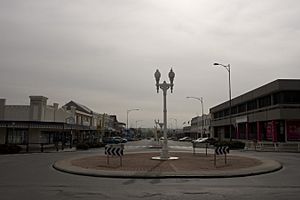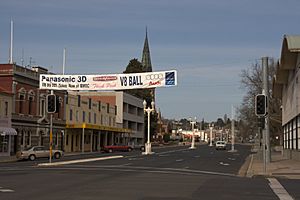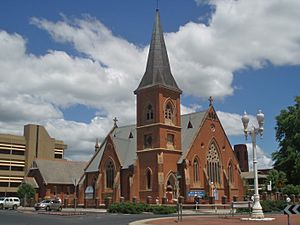Bathurst Street Lamps facts for kids
Quick facts for kids Bathurst Street Lamps |
|
|---|---|
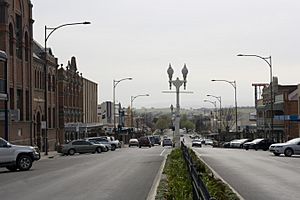
Street lamps located in William Street, Bathurst, pictured in 2010
|
|
| Location | Howick Street, Bathurst, Bathurst Region, New South Wales, Australia |
| Built | 1872–1924 |
| Owner | Bathurst Regional Council |
| Official name: Bathurst Street Lamps | |
| Type | State heritage (landscape) |
| Designated | 1 August 2003 |
| Reference no. | 1666 |
| Type | Other - Urban Area |
| Category | Urban Area |
| Builders | Not known |
| Lua error in Module:Location_map at line 420: attempt to index field 'wikibase' (a nil value). | |
The Bathurst Street Lamps are special street lights in the city of Bathurst, Australia. They are important because they are part of Australia's history. These lamps were built between 1872 and 1924.
There are 105 of these unique lamps. You can find them on streets like Howick, William, George, Keppel, Russell, and Church Streets. They are also in King's Parade and Machattie Park. These lamps were added to the New South Wales State Heritage Register on 1 August 2003. This means they are protected because of their historical value.
Contents
History of Bathurst's Street Lamps
Early Days and First People
Long ago, about 12,000 years ago, Aboriginal people lived in the Blue Mountains area. The land where Bathurst now stands was home to the Wiradjuri people. They moved around the Macquarie River area, finding food and setting up camps.
In 1813, European explorers first crossed the Blue Mountains. Then, in 1815, Governor Lachlan Macquarie officially started the town of Bathurst. He named it after Lord Bathurst. Bathurst is actually Australia's oldest town that is not on the coast!
How Bathurst Grew
Governor Macquarie picked the spot for Bathurst in 1815. A road was already built by convicts, led by William Cox. At first, Macquarie didn't want too many people settling in the rich Bathurst Plains.
In 1818, some land was given out for farms and town blocks. By 1819, Bathurst had about 120 people living in 30 houses. Most of these were in Kelso, across the river. The government also had buildings and a farm there.
Later, in 1830, the town of Bathurst was designed by Thomas Mitchell. The streets were laid out, and the first land sales happened in 1831. It's thought that Major Mitchell named the streets. For example, George Street was named after King George III.
Lighting Up the Streets
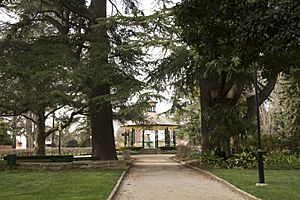
In 1863, the Bathurst Council decided to light the streets. They first used kerosene lamps. These lamps had to be lit from sunset to sunrise for most of the year.
Then, in 1872, gas became available in Bathurst. The old kerosene lamps were changed to use gas. Soon, two gas lamps were put at each main intersection in the city center. Property owners had to pay a special tax to cover the cost. By 1877, Bathurst had 55 street lights.
The street lamps we see today replaced the old gas lamps in 1924. This happened when electricity came to the city.
A special lamp and horse drinking fountain was put in Machattie Park in 1887. It was a memorial to Lady Mayoress M. L. Machattie. She led a group of women who helped create Machattie Park. The "Women and Girls of Bathurst" put it there.
In 1998, the Bathurst City Council took over owning all these historic street lamps.
What the Lamps Look Like
There are 105 lamps in total, and they come in a few styles:
- 49 lamps have two lights and are in the middle of Howick, William, George, and Keppel Streets.
- 2 lamps with two lights are in King's Parade.
- 53 lamps have a single light. You can find these in King's Parade, Machattie Park, and in the middle of Russell and Church Streets.
There's also the M.L. Machattie lamp/horse trough fountain. It's on the corner of George and Keppel Streets. It has a large drinking bowl for horses and a tall column with five lights on top. A plaque on the column says, "1887 Jubilee fountain erected by the Women and Girls of Bathurst, M.L. T. A Machattie, Mayoress".
The lamps in Machattie Park are generally older. They often have a single globe, like the original gas lights.
Most of the lamp posts were in fair condition in 2002. They needed repainting and cleaning. Some also had rust at the bottom. The M. L. Machattie fountain needed more work, especially its drinking bowl, which was rusty.
Even though they need some care, the Bathurst street lamps are still very complete and look much like they did when they were first installed.
Why They Are Special
The Bathurst street lamps are very important to the history and look of Bathurst. There are 105 of them, making them a large and rare collection. They show how the city grew and changed from using gas to electricity for lighting.
They are important for several reasons:
- They show history: These lamps are a great example of street lighting from the late 1800s and early 1900s. They show how Bathurst developed as a city.
- They are linked to people: The lamps show the work of the Bathurst City Council in providing services. The M. L. Machattie lamp and fountain is a special reminder of Lady Mayoress M. L. Machattie and her contribution to the city.
- They look great: The lamps are beautiful and unique. They are made of cast iron and mix old Victorian styles with newer Art Deco designs. They often have two lights on one pole, which is unusual. They make Bathurst's streets look very special.
- They are valued by the community: People in Bathurst really like these lamps. They see them as an important part of their city's history and identity.
- They can teach us more: These lamps can help us learn more about how street lights were designed and built a long time ago.
- They are rare: Having over 100 of these old, well-preserved lamps in one place is very rare in New South Wales. They are a unique example of the change from gas to electric lighting.



